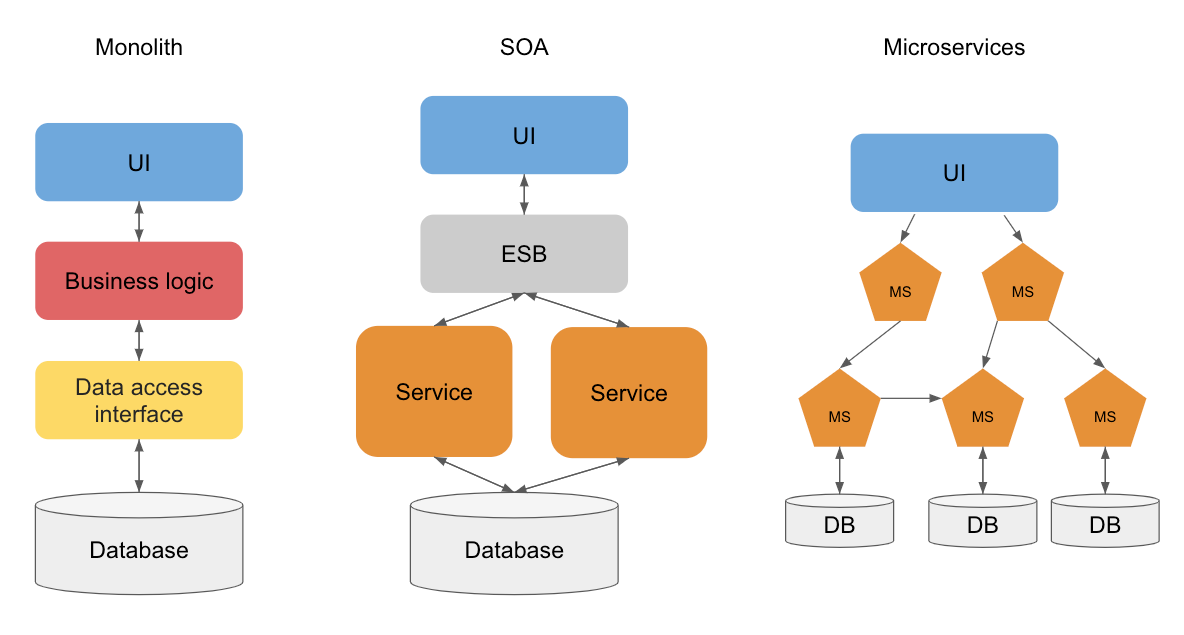This article aims to discuss the microservices architecture from its definition to a concrete example.
Plan:
- What is a microservices architecture?
- Advantages and disadvantages of a microservices architecture
- Orchestration vs Choreography
- Advice and good practices
- Proof of concept
The following results were produced via various sources: scientific publications, articles, videos, documentations from large companies, etc. These include the website of Martin Fowler, renowned software engineer and author, which contains an extensive documentation on microservices.
1. What is a microservices architecture?
Essentially, microservices architecture is a method of software development that aims to break down an application to isolate key functions, each of these functions is called a “service”. These services are designed to meet a specific and unique business need, for example: user management, payments, sending emails or even notifications. In addition, they are independent and modular, this allows each to be developed and deployed without affecting the others. This type of architecture is intended to be the opposite of monolithic architectures which are built as a single autonomous unit.
This definition may recall another type of architecture quite similar, Service Oriented Architecture (SOA), a software design already well stated.
What makes an SOA architecture different from a microservices architecture?
Let’s start with a clear observation, made by the precursors of microservices: this architecture is an extension of the concept of SOA. Most of the design principles for microservices were already available in the SOA world. Some people claim that “the microservices architecture is a well-designed SOA architecture.” Let’s see the differences between SOA and microservices along several axes:
- Size: One of the big differences is the size and scope of services. As you can guess from the name, in microservices, the size of each service is much smaller than the one of SOA services. In a microservices architecture, each service has a single responsibility while in the SOA architecture, services can contain many business functions.
- Reusability: One of the goals of SOA is to reuse components without worrying about coupling while in microservices we try to minimize reuse since this creates dependencies that reduce agility and resiliency. A weak coupling is preferred, even if it means having code duplication.
- Communication: In SOA, communication between services is usually done synchronously through an enterprise service bus (ESB), this introduces a critical point of failure and latency. In a microservices application, fault tolerance is better thanks to the independence of each service, asynchronous communication is also privileged between services (for example a publish subscribe model can be used to allow a service to stay up to date on changes to another one’s data), enabling high availability.
- Data duplication: One of the goals of an SOA is to allow all applications to access data synchronously directly at the source. With a microservices architecture, each service has access to all the data it needs locally (ideally) to have maximum performance and agility, even if this means having to duplicate data and therefore add complexity.
Let’s sum it all up with a diagram:

2. Advantages and disadvantages of a microservices architecture
Now that we have a better understanding of what a microservices architecture is, let’s see what are the advantages and disadvantages of it compared to a monolith architecture. We’ve seen a number of benefits before, but let’s go over them all:
- Independent Development: Teams can choose the technologies that best suit each service using various technology stacks and are not limited by the choices made at the start of the project. Additionally, a single development team can build, test, and deploy a service, enabling faster deployment and facilitating continuous innovation. It is also more difficult to make mistakes since there are strong boundaries between the different services.
- Independent deployment: Microservices are deployed independently. A service can be updated without having to redeploy the entire application, making it easier to manage bug fixes and new features. This simplifies integration and continuous deployment. In many traditional applications, if there is a bug in one part of the application, it can block the entire release process.
- Independent scaling: Services can scale independently to suit needs, optimizing costs and time since there is no need to scale the entire application as you would with a monolith.
- Small Targeted Teams: Teams can be targeted to only one service, making code easier to understand and making it easier for new members to join the team, no need to spend weeks figuring out how a complex monolith works. It also promotes flexibility, large teams tend to be less productive because communication is slower, management time increases and agility decreases.
- Small Code Base: In a monolithic application, code dependencies tend to get mixed up over time. Adding new functionality requires changing the code in a lot of places. In a microservices architecture, which does not share code or database, these dependencies are minimized, which makes it easier to add new features. It also complements the previous point that it makes it easier to understand the code and introduce new members to the team.
- Data isolation: In a microservices architecture, each service has private access to its database (ideally), we can then perform an update of the database schema without affecting the other services. In a monolithic application, schema updates can become very difficult and risky since multiple parts of the application can use the same data.
- Resilience: With a microservices architecture, critical points of failure are considerably reduced. When a service goes down, the whole application does not stop functioning as it does with the monolithic model and therefore the risk is also reduced when new features are developed. Errors are also isolated and therefore easier to correct.
- Technological Advances: Recent advancements in cloud technologies and containerization make setting up a microservices architecture increasingly simple. Every cloud provider has solutions for this type of architecture to make life easier for developers.
Now that we have a better idea of all the advantages of a microservices architecture, let’s see what the disadvantages and challenges are:
- Complexity: While each service is simpler, the system as a whole is more complex. Because this is a distributed system, care should be taken to select and set up all services and databases, and then deploy each of these components independently. All the challenges of a distributed system must be taken into account.
- Testing: Having multitude independent services can make writing tests more complex, especially when there are many dependencies between services. A mock must be used for each dependent service to be able to unit test a service.
- Data Integrity: Microservices have a distributed database architecture, which is a challenge for data integrity. Some business transactions, which require updating multiple business functions of the application, need to update multiple databases owned by different services. This requires setting up eventual consistency of data, which is obviously more complex and less intuitive for developers.
- Network latency: Using many small services can result in increased communications between services. Also, if you have a chain of dependency between services to perform a business transaction, the additional latency that results can become a problem. Asynchronous communications should be favored when usage permits, but this once again adds complexity to the system.
According to these advantages and disadvantages it is then more or less relevant to adopt a microservices architecture, there is no universal rule, each project is unique and the motivations towards one architecture or the other depend on the needs and the context of it.
#microservices #javascript #programming #developer
